Kerala Plus One Botany Chapter Wise Questions and Answers Chapter 4 Anatomy of Flowering Plants
Plus One Botany Anatomy of Flowering Plants One Mark Questions and Answers
Question 1.
Both apical and intercalary meristems are meristems
(a) primary
(b) secondary
(c) lateral
(d) none of these
Answer:
(a) primary
Question 2.
Sclerieds present in
(a) fruit wall of nuts
(b) pulp of guava
(c) seed coat of legumes
(d) all of these
Answer:
(d) all of these
Question 3.
Which of the following condition of xylem is present in both monocot and dicot stems
(a) exarch
(b) endarch
(c) polyarch
(d) mesarch
Answer:
(b) endarch
Question 4.
Bark does not include
(a) secondary xylem
(b) secondary phloem
(c) periderm
(d) primary phloem
Answer:
(a) secondary xylem
Question 5.
…………… is the living mechanical tissue
(a) collenchyma
(b) parenchyma
(c) sclerenchyma
(d) none of these
Answer:
(a) collenchyma
Question 6.
What are the cells that make the leaves curl in plants during water stress?
Answer:
Bulliform cells/motor cells
Question 7.
What part of the plant would show the following:
(a) Radial vascular bundle
(b) Polyarch xylem
(c) Well developed pith
Answer:
(a) Radial vascular bundle
Question 8.
Apical meristem for elongation of Stem, Lateral meristem for ………..
Answer:
Increase in thickness.
Question 9.
While analysing the anatomy of a given slide, phloem, cambium & xylem are present. Identify the material.
Answer:
Dicot stem.
Question 10.
Tissues are specialised to perform mechanical function have thickening at corners, living and cellulosic. Name it.
Answer:
Collenchyma
Question 11.
A cross-section of plant materials show the following features under microscope there are many vascular bundles scattered in the parenchymatous tissue, xylem is endarch. What kind of plant part shows the above anatomy.
Answer:
Monocot stem
Question 12.
Name tissue which provides mechanical strength to the plant’s organs.
Answer:
Sclerenchyma and xylem
Question 13.
What does the fascicular cambium gives rise to?
Answer:
Secondary vascular tissues and medullary rays
Question 14.
From where do the secondary cambium appear?
Answer:
From permanent tissues
Question 15.
Which type of meristems can be classified on the basis of positions in the plant body.
Answer:
Apical, intercalary and lateral
Question 16.
Find the odd one and give reason:
Phellem, Phellogen, Phloem, Phelloderm
Answer:
Phloem. The other components are part of periderm
Question 17.
Fill in the blanks:
Stem: Endarch:: Root: ……….
interfascicular cambium: secondary xylem:: cork cambium: …………
Answer:
Exarch, phelloderm
Question 18.
Activity of cambium is different in two seasons and xylem vessels formed have narrow and wider lumens. Give the type of wood formed during the different seasons.
Answer:
Springwood and autumn wood.
Question 19.
What use are phloem fibres put to
Answer:
Phloem fibers of plants like jute are used for making ropes.
Question 20.
Identify the plant group from the data given below.
(a) Habit-Tree
(b) Xylem vessels present
(c) Absence of companion cells in phloem
(d) No fruits
Answer:
Gymnosperm
Question 21.
Ramu observed the growth of a plant in his garden. He realised that the plant grow both in length and width. Name the tissue responsible for the growth of the plant.
Answer:
Meristems
Question 22.
A cross-section of plant materials show the following anatomical features under microscope.
- Vascular bundles are radially arranged
- Four xylem strands with exarch condition of the protoxylem. To which organ should it be assigned?
Answer:
Dicot root
Question 23.
The transverse section of a plant material shows the following anatomical features.
- vascular bundles are conjoint, scattered and surrounded by a sclerenchymatous bundle sheath.
- Phloem parenchyma is absent. What will you identify as?
Answer:
The plant is a monocotyledon.
Question 24.
The cross-section of a plant material showed the following features when viewed under the microscope.
- The vascular bundles were radially arranged.
- Four xylem strands with exarch condition of protoxylem.
To which organ should it be assigned?
Answer:
Dicot root
Plus One Botany Anatomy of Flowering Plants Two Mark Questions and Answers
Question 1.
During the secondary thickening of a dicot stem, from the outer cotical region, a meristematic tissue is developed. Name this tissue and write the function of it.
Answer:
Phellogen/cork cambium – It produces phellum towards the outer sides & phelloderm towards the inner side. These 3 layers are known as periderm
Question 2.
Analyse the table and arrange the matter is an appropriate order.
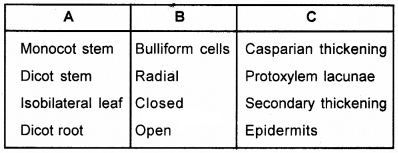
Answer:
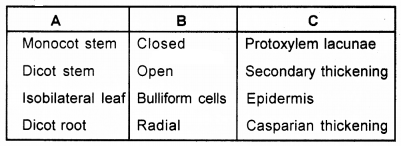
Question 3.
Differentiate the following characters of dicot stem and monocot stem.
Differentiated cortex, Protoxylem lacuna present, open bundle, bundle sheath, starch sheath, sclerenchymatous hypodermis, scattered bundles, V.Bs. arranged in a ring, closed bundles, phloem parenchyma absent, presence of pith, collenchymatous hypodermis.
Answer:
| Dicot stem | Monocot stem |
| Differentiated cortex Open bundle Starch sheath V.Bs arranged in ring Presence of pith collenchymatous hypoderms | Protoxylem lacuna present Bundle sheath Closed bundle Phloem parenchyma absent Sclerenchymatous hypoderms |
Question 4.
Xylem is the complex tissue that transports water in plants.
- Name the main components of xylem.
- Which of these is most likely suitable for conducting water?
Answer:
- Xylem parenchyma, vessels, tracheid, xylem fibers.
- Vessels
Question 5.
Examine the anatomy of two plants
- Xylem vessels and tracheids are seen
- Xylem vessels absent and tracheids present
Answer:
- Angiosperm
- Gymnosperm
Question 6.
Identify the figure ‘A’ and ‘B’ and differentiate between ‘A’ and ‘B’.
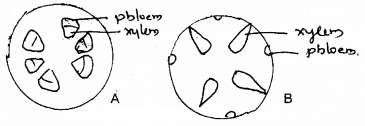
Answer:
| A | B |
| Dicotstem | Dicot root |
| Vascular bundles are arranged in a ring, limited no., conjoint, endarch & open | Vascular bundles are radial, exarch |
Question 7.
Secondary growth occurs in dicots and no such growth in monocots. Justify.
Answer:
In dicots, cambium is present in their vascular bundle. In monocot, cambium is absent in the vascular bundles. So secondary growth occurs in dicotyledons and not in monocotyledons.
Question 8.
Phloem is called the complex tissue while parenchyma is a simple tissue. Make the differences
Answer:
Phloem is made up of more than one type of cells namely, sieve tube, companion cell, phloem parenchyma & phloem fiber. Parenchyma consists of same types of cells.
Question 9.
When the cross-section of a stem was examined, a student could notice collenchymatous hypodermis, Limited number of open vascular bundles, cortex, endodermis, and pith.
- Identify the material.
- Draw the diagram of the material showing these parts and label.
Answer:
1. Dicot stem
2.

Question 10.
Observe the diagrams and identify the tissue types.
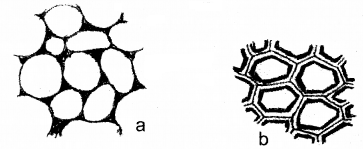
Answer:
a. Collenchyma
b. Sclerenchyma
Question 11.
Analyse the table and arrange the matter in an appropriate order.
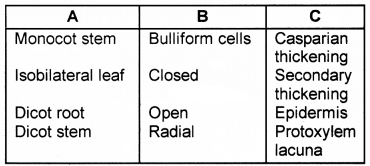
Answer:

Question 12.
While doing anatomy practical, students observe ten following characters:
- Undifferentiated ground tissue.
- Numerous vascular bundles and are scattered.
- Sclerenchymatous hypodermis
- Presence of bundle sheath
1. Identify the material.
2. Write any one example of a plant having such characters.
Answer:
- Monocot stem.
- Grass/Bamboo
Question 13.
What is the function of phloem parenchyma?
Answer:
The phloem parenchyma stores food material and other substances like resins, latex, and mucilage.
Question14.
How do you correlate the activity of cambium with changing seasons?
Answer:
During winter season the cambium stops its activity. In spring season cambium becomes more active and produce large quantity of secondary tissue. The secondary xylem produced during spring season is called springwood. During autumn season and summer season the cambium becomes less active and produces small quantity of secondary tissue. The secondary xylem produced during this period is called autumn wood.
Question 15.
Mention the characteristic features of sieve-tube members.
Answer:
Sieve tubes are cylindrical have endplates called sieve plates. They are dead elements of phloem.
Question 16.
It is difficult to open and close wooden doors and windows during the rainy season. What is the reason?
Answer:
Imbibition It is the absorption of water by water-loving particles without forming a solution
Question 17.
Heartwood is resistant to microorganisms. Justify the statement.
Answer:
Contains alkalloids, tannins & resins
Question 18.
The microscopic observation is given below.
- Identify A and B.
- Write any two distinguishing characters of the above diagram.
Answer:
- A dicot stem B monocot stem
- In dicot stem vascular budles open, limited no.&arranged in the form of a ring. In monocot stem, vascular bundles closed, numerous & scattered
Question 19.
Simple tissues that perform mechanical support in plants are usually dead tissues’
Name the living simple tissue that provides mechanical support to plant organs. In which category of plants (dicots/monocots) do they found?
Answer:
Sclerenchyma tissues Monocots
Question 20.
What is present on the surface of the leaves which helps the plant prevent loss of water but is absent in roots?
Answer:
The cuticle is the waxy substance that prevents excessive water loss.
Question 21.
What is the epidermal cell modification in plants which prevents water loss?
Answer:
The presence of bulliform cells in the leaves of monocot plants, which helps in rolling and unrolling of lamina and prevents water loss.
Question 22.
Arrange the following in the sequence you would find them in a plant starting from the periphery – phellem. phellogen. phelloderm.
Answer:
phellem, phellogen, phelloderm.
Question 23.
A transverse section of the trunk of a tree shows concentric rings which are known as growth rings. How are these rings formed? What is the significance of these rings?
Answer:
It is formed due to the activity of vascular ambium. The growth ring comprises springwood and autumn wood that is formed in spring season and winter season respectively. These are used to determine the age of tree by counting the number of concentric rings.
Question 24.
While eating peach or pear it is usually seen that some stone-like structures get entangled in the teeth, what are these stone-like structures called?
Answer:
USB Non-elongated sclerenchyma(sclereids)
Question 25.
When your teacher asked to collect different types of seeds. One of the students collected some seeds from a tree. These seeds have no covering or naked.
- In which group of plants does this tree belong?
- Which portion of the plant develops into the seed?
Answer:
- Gymnosperms
- Ovule
Question 26.
We cannot find the woody trunk in monocot plants. Why?
Answer:
Monocots do not possess cambium Hence, the secondary tissues are not formed.
Question 27.
Identify the following materials under microscope.
- Xylem polyarch, Round vessels, homogenous cortex with xylem & phloem in radial manner.
- Endarch xylem, conjoint bundle, surrounded by bundle sheath, palisade and spongy tissues distinguished and kidney-shaped guard cells
Answer:
- Monocot root
- Dicot leaf
Question 28.
The product of photosynthesis is transported from the leaves to various parts of the plants and stored in some cells before being utilised. What are the cells/ tissues that store them?
Answer:
parenchyma tissue
Question 29.
Name the kind of vascular bundle in Fig. a and b.
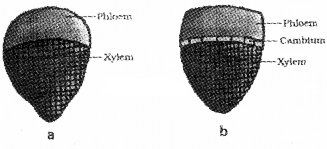
Answer:
a. Closed bundle
b. Open bundle
Question 30.
Heartwood is resistant to micro-organisms. Justify the statement.
Answer:
The deposition of substances like Tannin, resin, oil, gum, aromatic substances and essential oil in the central part of wood helps to resist the attack of microorganisms.
Question 31.
Cambial ring is responsible for the formation of secondary vascular tissues both in Dicot stem and Dicot root. Differentiate the origin of cambial ring in Dicot stem and Dicot root.
Answer:
1. In Dicot stem, the conjuctive tissues in between the vascular bundles become meristematic and form. interfascicular cambium, it joins with intrafascicular cambium to form a cambial ring.
2. In Dicot root, the tissue just below phloem and part of pericycle tissue above the protoxylem join together to form a wavy ring. Later it becomes circular.
Question 32.
Give reason
- Grittiness nature of sapota fruit pulp
- Increase the thickness of stem intake and not in coconut
Answer:
- Due to the presence of nonelogated sclerenchyma tissues (sclereids)
- In Teak, cambium is present (dicot plant) In coconut, cambium is absent because it is a monocot plant.
Cambial activity causes an increase in thickness
Question 33.
Match the following.
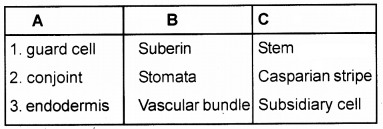
Answer:

Question 34.
You may have observed droplets of water at the tip of leaves of grasses during early morning. Your sister told it is a dewdrop.
As a science student do you agree with her? Explain. Compare this process with transpiration.
Answer:
No.
- The droplets of water are found in the tip of grass leaves. This is called Guttation. It occurs in early morning.
- Water drops come out from Hydathode seen in the vien endings of leaf.
- Transpiration is the loss of water in the form of water vapour from stomata of leaves.
Question 35.
How can we correlate the activity of cambium with changing season?
Answer:
In spring season the activity of cambium is more and produces large no. of xylem vessels with wide lumen. But in Autumn season the activity of cambium is less and produces fewer no.of xylem vessels with narrow lumen.
Question 36.
Classify the following characters under dicot and monocot stem?
Bundle sheath is present, open bundle, bundle cap is present, closed bundle, arranged in a broken ring, scattered bundle, collenchymatous hypodermis, sclerenchymatous hypodermis.
Answer:
| Dicot stem | Monocot stem |
| Open bundle Bundle cap is present Arranged in a broken ring collenchymatous Hypodermis | Bundle sheath is present Closed bundle Scattered bundle Sclerenchymatous Hypodermis |
Question 37.
Distinguish between cork cambium and vascular cambium.
Answer:
1. Cork cambium is the meristematic layer that cut of the tissues outside called phellem and inside phelloderm.
2. Vascular cambium is the meristematic layer that cut of the tissues outside called secondary phloem and inside secondary xylem.
Question 38.
Identify the following diagram and write its function.

Answer:
Hydathode. It is the pore found in the vein ending of the grass leaf through which water loss occurs in the form of droplets.
Question 39.
Which one out of the root or stem shows endarch arrangement of xylem? What is meant by endarch arrangement?
Answer:
Stem, In edarch xylem protoxylem, is present towards the centre (pith) and metaxylem is faced towards outside.
Question 40.
Observe the diagram and identify the tissue types. Justify your answer.
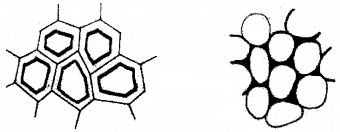
Answer:
- The first figure is the Sclerenchymatus tissue.
- The second figure is collenchymatous tissue.
- In sclerenchyma tissue, the cell walls are lignified and dead.
- In collenchymatous tissue, the cell walls are thick and living.
Question 41.
What are bulliform cells? Mention its significance
Answer:
These are the specialised cells found in the epidermis of monocot leaf. They are otherwise called as motor cells.
It helps in the rolling and unrollong of lamina
Question 42.
Where are the companion cells located in the flowering plants? What are their functions?
Answer:
Companion cells are located in the phloem cells of vascular tissue. They support the sieve tubes.
Question 43.
What category of permanent plant cell is a companion cell?
Answer:
Companion cells are specialised thin-walled parenchymatous cells found to be associated with sieve tubes.
Question 44.
Sieve tubes in angiosperms are associated with specialised parenchyma cells. Name those cells. How do they help sieve-tube members?
Answer:
Companion cells, help in physiological working of sieve-tube members.
Question 45.
- Name the various components of xylem.
- Which of them does not have a nucleus?
Answer:
- Tracheids, vessels, xylem parenchyma, and xylem fibers.
- Tracheids, vessels, and xylem fibers
Question 46.
How are exarch and endarch conditions different anatomically in stem and root?
Answer:
1. The anatomical condition is endarch in dicot as well as monocot stem.
2. In endarch condition protoxylem lie towards inner side of vascular budle However, in anatomy of root.the condition is exarch.i.e protoxylem is towards outer side and metaxylem is towards centre.
Question 47.
Cork cambium forms tissues that form the cork. Do you agree with this statement? Give reasons.
Answer:
Cork cambium develops in cortex region during secondary growth in stem. Cork cambium cut off cork (phellum) towards the outside and secondary cortex or phellodem towards the inner-side.
Question 48.
If one debarks a tree, what parts of the plant is being removed?
Answer:
Phloem is removed and food translocation becomes difficult.
Question 49.
What is periderm? How does periderm formation take place in the dicot stems?
Answer:
Phellogen, phellem, and phelloderm are together known as periderm. Due to secondary growth of the stem, the outer cortical and epidermis layer broken and replaced by another meristematic issue called phellogen. Phellogen or cork cambium cuts off cells on both sides the outer cells are called cork or phellem and the inner cells are phelloderm or secondary cortex.
Question 50.
Some anatomical details of material are given below vascular bumdles are conjoint and open, medullary rays are present, hypodermis collenchymatous, cortex heterogenous
- Identify the material
- Name the tissue given above from which interfascicular cambium develops during secondary growth.
Answer:
- Dicot stem
- Medullary ray
Question 51.
Three type of tissues formed during secondary growth together have protective functions.
- Name the three types
- Name the opening found in outer part of mature woody dicot stem and give its function
Answer:
- phellem, phellogen, and phelloderm
- lenticel, gaseous exchange
Question 52.
- Distinguish between heartwood and sapwood.
- Heartwood is durable why?
Answer:
1. Distinguish between heartwood and sapwood
Heartwood
- found in the central part
- nonfunctional
- dark coloured
Sapwood
- found in peripheral part
- functional
- light coloured
2. Heartwood is resistant to microbial attack and it is filled with resin, gum, essential oil, aromatic oil, and tannins. Hence heartwood is durable.
Plus One Botany Anatomy of Flowering Plants Three Mark Questions and Answers
Question 1.
A portion of the transverse section of maize stem is shown in the diagram.
Label a, b, c, d, e, f, g, h and i.
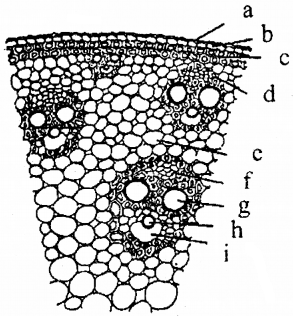
Answer:
- a – Cuticle
- b – Epidermis
- c – Sclerenchymatous hypodermis
- d – Sclerenchymatous sheath
- e – Parentchymatous sheath
- f – Phloem
- g – Metaxylem
- h – Protoxylem
- i – Water cavity.
Question 2.
Differentiate the following
- Bark & Periderm
- Heartwood &Sapwood
- Endarch & Exarch
Answer:
1. Bark – It is the tissue outside vascular cambium.
Periderm – It is the outer protective tissue It includes phellem, phellogen, and phelloderm.
2. Heartwood – It is the dark coloured, nonfunctional central part of wood resistant to the attack of microorganisms.
Sap wood – It is the light coloured, functional and peripheral part of wood.
3. Endarch – It is the arrangement of xylem in which protoxylem facing towards cente and metaxylem towards the periphery, eg. stem.
Exarch – It is the arrangement of xylem in which Metaxylem facing towards centre and protoxylem towards the periphery. eg: Root.
Question 3.
Match column A with B and C.
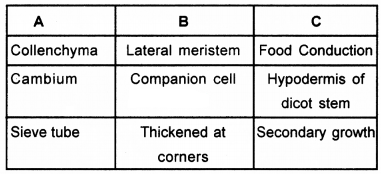
Answer:
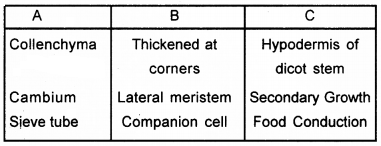
Question 4.
Match the Following.
| A | B |
| Nostoc | Protonema |
| Gonyaulax | respiratory root |
| Chlorella | red tide |
| Cycas | Space travelers |
| Rhizophora | heterocyst |
| Funaria | Coralloid root |
Answer:
| A | B |
| Nostoc | heterocyst |
| Gonyaulax | red tide |
| Chlorella | Space travelers |
| Cycas | Coral loid root |
| Rhizophora | Respiratory root |
| Funaria | Protonema |
Question 5.
The following are the characters of Dicot stem and Monocot stem. Identify the character and write in appropriate column.
- collenchymatous hypodermis
- Sclerenchymatous hypodermis
- Open bundle
- Closed bundle
- Bundle cap present
- Bundle sheath present
- Xylem polygonal
- Xylem circular
| Dicot stem | Monocot stem |
Answer:
| DICOTSTEM | MONOCOT STEM |
| a | b |
| c | d |
| e | f |
| g | h |
Question 6.
Plant growth is indeterminate in most plants it can go on indefinitely at the tips of roots and shoots. Special types of tissues are located at these regions
- Name those tissues
- Classify these tissues based on the position and origin.
Answer:
- Meristematic tissues
- Based on the position they are classified into three types,
- apical meristem
- intercalary meristem and
- lateral meristem
Based on the origin, they are classified into 2.
- primary meristem and
- Secondary Meristem
Question 7.
1. Choose from among the following key terms and
complete the chart given below.
conjoint, closed, exarch open, …………. large, ……………. small endarch, radial ……….. few in a ring, ……….. many xylem and phloem bundles
few.
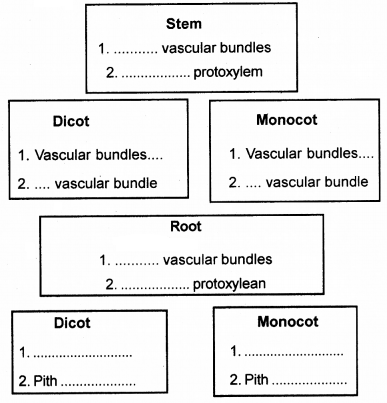
2. Comment on the utility of this chart.
Answer:
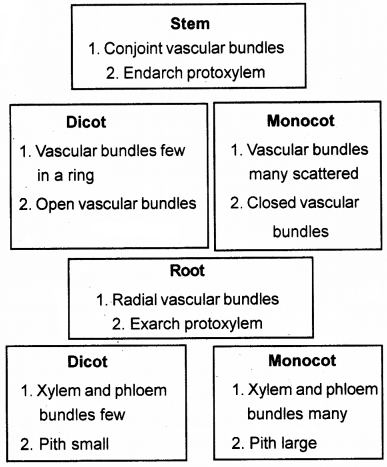
Question 8.
The following schematic representation shows the classification of complex tissues. Complete it.
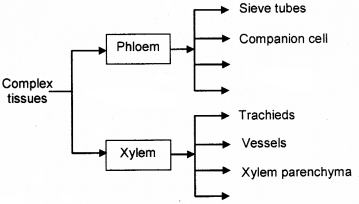
Answer:
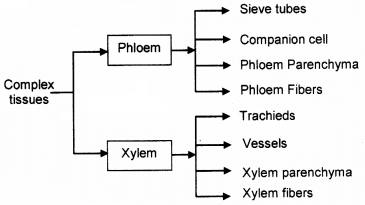
Plus One Botany Anatomy of Flowering Plants NCERT Mark Questions and Answers
Question 1.
Name the three basic tissue systems in the flowering plants. Give the tissue names under each system.
Answer:
On the basis of their structure and location, there are three types of tissue systems:
- Epidermal Tissue System. Epidermis, Stomata.
- Ground or Fundamental Tissue System Parenchyma, Sclerenchyma and Collenchyma.
- Vascular or conducting Tissue System. Phloem and Xylem.
Question 2.
The transverse section of a plant material shows the following anatomical features
- the vascular bundles are conjoint, scattered and surrounded by a sclerenchymatous bundle sheath.
- phloem parenchyma is absent. What will you identify as?
Answer:
As is clear from above TS of monocot stem vascular bundles are scattered in monocot stems and phloem parenchyma is absent.
Question 3.
Why are xylem and phloem called complex tissues?
Answer:
Xylem and phloem are composed of several types of cells and they work as a unit. Hence they are called complex tissues.
Question 4.
What is the stomatal apparatus? Explain the structure of stomata with a labelled diagram.
Answer:
Stomata are structures present in the epidermis of leaves. Stomata regulate the process of transpiration and gaseous exchange. Each stomata is composed of two bean-shaped cells known as guard cells. In grasses, the guard cells are dumbbell-shaped.
The outer walls of guard cells (away from the stomatal pore) are thin and the inner walls (towards the stomatal pore) are highly thickened. The guard cells possess chloroplasts and regulate the opening and closing of stomata.
Plus One Botany Anatomy of Flowering Plants Multiple Choice Questions and Answers
Question 1.
Interfascicular cambium is a
(a) primary meristematic tissue
(b) primordial meristem
(c) type of proto deny
(d) secondary meristematic tissue
Answer:
(d) secondary meristematic tissue
Question 2.
In an annual ring, the light coloured part is known as
(a) earlywood
(b) late wood
(c) heartwood
(d) sapwood
Answer:
(a) earlywood
Question 3.
The layer of cells outside the phloem meant for giving rise to the root branches is called
(a) cambium
(b) cork
(c) endodermis
(d) pericycle
Answer:
(d) pericycle
Question 4.
Cork cambium of dicot originates from
(a) epiblema
(b) pericycle
(c) the cambium of vascular bundles
(d) endodermis
Answer:
(b) pericycle
Question 5.
Alburnum is otherwise known as
(a) periderm
(b) sapwood
(c) heartwood
(d) cork
Answer:
(b) sapwood
Question 6.
Duramen is present in
(a) inner region of secondary wood
(b) part of sapwood
(c) outer region of secondary wood
(d) region of pericycle
Answer:
(a) inner region of secondary wood
Question 7.
Which one of the following is the correct sequence of tissues present in dicot stem during secondary growth
(a) Phellogen, cork, primary cortex, secondary cortex
(b) Cork, primary cortex, secondary cortex, phellogen
(c) Primary cortex, secondary cortex, phellogen, cork
(d) Secondary Cortex, phellogen, cork .primary cortex
Answer:
(d) Secondary Cortex, phellogen, cork .primary cortex
Question 8.
The meristem responsible for extra stelar secondary growth in dicot stem is
(a) interfascicular cambium
(b) intrafascicular cambium
(c) intercalary meristem
(d) phellogen
Answer:
(d) phellogen
Question 9.
Tracheids
(a) are the dominant cell types of xylem in angiosperms
(b) are primarily found in mosses and liverworts
(c) are responsible for water conduction and support in many land plants.
(d) first appeared during Palaeozoic era
Answer:
(c) are responsible for water conduction and support in many land plants.
Question 10.
In the following, how the sapwood is converted into heartwood?
(a) By degeneration of protoplast of living cells
(b) Tyloses formation
(c) By deposition of resins, oils, gums, etc
(d) All of the above
Answer:
(d) All of the above
Question 11.
As secondary growth proceeds in a dicot stem, the thickness of
(a) sapwood increases
(b) heartwood increases
(c) both sapwood and heartwood increase
(d) both sapwood and heartwood remains the same
Answer:
(c) both sapwood and heartwood increase
Question 12.
Which is not a characteristic of plant cell walls?
(a) Found only in the sporophyte phase of life cycle
(b) Among other compounds contains compounds built of simple sugars
(c) May contain enzymes that are biologically active
(d) Often contain strengthening polymers
Answer:
(a) Found only in the sporophyte phase of life cycle
Question 13.
Identify the correct order of the components with reference to their arrangement from outer side to inner side in a woody dicot stern.
- Secondary cortex
- Autumn wood
- Secondary phloem
- Phellem
(a) 2,3, 1,4
(b) 3,4,2,1
(c) 4, 1,3,2
(d) 1,2,4,3
Answer:
(c) 4, 1,3,2
Question 14.
Removal of ring wood of tissue outside the vascular cambium from the tree trunk kills it because
(a) water cannot move up
(b) food does not travel down and root become starved
(c) shoot become starved
(d) annual rings are not produced
Answer:
(b) food does not travel down and root become starved
Question 15.
Which tissue gives rise to secondary growth?
(a) Apical meristem
(b) Adventitious roots
(c) Germinating seed
(d) Vascular cambium
Answer:
(d) Vascular cambium
Question 16.
Growth rings are formed due to the activity of
(a) extrastelar cambium
(b) intrastelar cambium
(c) interstelar cambium
(d) Both (b) and (c)
Answer:
(d) Both (b) and (c)
Question 17.
A nail is driven into the trunk of a 30 years old tree at a point l in above the soil level. The tree grows in height at the rate of 0.5m a year. After three years, the nail will be
(a) 1m above the soil
(b) 1.5 m above the soil
(c) 2 in above the soil
(d) 2.5 m above the soil
Answer:
(a) 1m above the soil
Question 18.
In which of the following, there is no differentiation of bark, sapwood, and heartwood?
(a) Ashok
(b) Neem
(c) Mango
(d) Datepalm
Answer:
(d) Datepalm
Question 19.
A tree grows at a rate of 0.5 m per year. What will be the height of the board fixed at 1.5 m above the base five years ago?
(a) 4.0 m
(b) 3.5 m
(c) 1.5 m
(d) 4.5 m
Answer:
(c) 1.5 m
Question 20.
Secondary phloem remains functional generally
(a) for one year
(b) for less than one year
(c) for many years
(d) as long as the plant is alive
Answer:
(d) as long as the plant is alive
